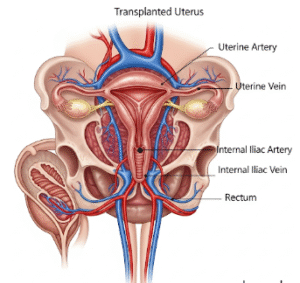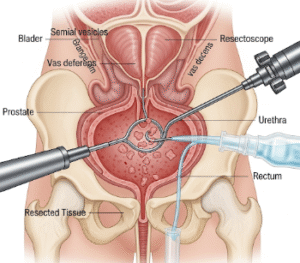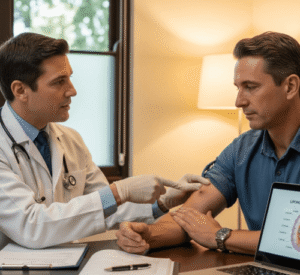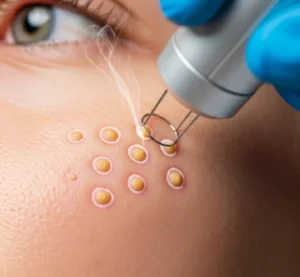➤ Overview
Swelling in the groin, medically referred to as inguinal swelling, occurs when the soft tissues in the groin area become enlarged or protrude. This can affect one or both sides and may be caused by lymph node enlargement, hernias, infections, or other medical conditions.
In South Korea, groin swelling is evaluated by general surgeons, urologists, and primary care physicians. Proper diagnosis is essential to identify the underlying cause, initiate appropriate treatment, and prevent potential complications.
➤ Key Facts
→ Groin swelling can affect both children and adults, with different underlying causes depending on age.
→ The swelling may be painful or painless, soft or firm, and accompanied by other systemic symptoms.
→ Common triggers include infections, hernias, trauma, or tumors.
→ In Korea, diagnosis often involves physical examination, imaging studies, and laboratory tests.
→ Early evaluation prevents complications such as strangulated hernia, abscess formation, or chronic infection.
→ Treatment may be medical, surgical, or supportive, depending on the underlying cause.
→ Lifestyle measures and hygiene play a role in prevention and management of recurrent or infection-related swelling.
➤ What is Swelling in the Groin?
Groin swelling refers to enlargement of soft tissues or lumps in the inguinal region, which can originate from several structures:
→ Inguinal lymph nodes – Enlarged due to infection, inflammation, or malignancy.
→ Hernias – Protrusion of abdominal contents through the inguinal canal.
→ Cysts or lipomas – Benign masses in the groin region.
→ Abscesses – Localized collections of pus due to bacterial infection.
→ Vascular causes – Varicose veins or lymphatic obstruction leading to swelling.
→ Trauma-related swelling – Hematoma or soft tissue injury.
→ Chronic swelling – May indicate systemic disease such as cancer or chronic infection.
Korean healthcare providers classify groin swelling based on location, size, consistency, tenderness, and associated symptoms to guide treatment.
➤ What Symptoms are Related to Swelling in the Groin?
Symptoms vary depending on the underlying cause:
→ Visible lump or bulge in the groin area.
→ Pain or tenderness – Especially in infections, hernias, or trauma.
→ Redness or warmth – Suggesting infection or inflammation.
→ Changes in skin texture – Thickening, ulceration, or discoloration in chronic cases.
→ Fever or malaise – May accompany infectious causes.
→ Digestive symptoms – Nausea or vomiting if hernia is obstructed.
→ Mobility issues – Discomfort during walking or bending.
→ Fluctuating size – Swelling may increase with activity and reduce at rest (common in hernias).
→ Swelling in adjacent areas – Thigh or lower abdomen may also appear swollen.
➤ What Causes / Possible Causes?
Groin swelling can result from infectious, structural, vascular, or systemic causes:
→ Inguinal hernia – Most common cause; intestines or fat protrude through inguinal canal.
→ Lymphadenopathy – Enlargement of lymph nodes due to infection, inflammation, or malignancy.
→ Abscess or cellulitis – Local bacterial infection causing swelling and pain.
→ Cysts or benign tumors – Lipomas, sebaceous cysts, or epidermoid cysts.
→ Trauma or hematoma – Injury to groin or upper thigh.
→ Vascular causes – Varicose veins, deep vein thrombosis, or lymphatic obstruction.
→ Systemic diseases – Cancer, tuberculosis, or chronic infections causing lymph node enlargement.
→ Sexually transmitted infections (STIs) – Can lead to painful lymph node swelling.
→ Inflammatory conditions – Autoimmune or chronic inflammatory disorders.
➤ When Should I See My Doctor?
Immediate medical attention is recommended if groin swelling is severe, painful, or accompanied by systemic symptoms:
→ Rapidly enlarging swelling or sudden pain.
→ Redness, warmth, or signs of infection.
→ Fever, chills, or malaise indicating systemic infection.
→ Nausea, vomiting, or bowel obstruction (possible strangulated hernia).
→ Persistent or recurrent swelling without clear cause.
→ Hard, irregular, or fixed lumps suggesting malignancy.
→ Swelling associated with urinary or sexual symptoms.
→ No improvement with home care or conservative measures.
Early evaluation in Korea helps prevent complications, initiate timely treatment, and improve outcomes.
➤ Care and Treatment
Treatment depends on underlying cause, severity, and risk of complications:
→ Hernia management – Surgical repair to prevent strangulation or obstruction.
→ Infection management – Antibiotics for abscesses or cellulitis.
→ Incision and drainage – For abscesses or fluid collections.
→ Pain relief and anti-inflammatory medications – Reduce discomfort.
→ Supportive care – Rest, ice packs, or compression for mild swelling.
→ Observation – Small, painless lymph node swelling may be monitored.
→ Lifestyle modifications – Weight management, avoiding heavy lifting, and hygiene measures.
→ Referral to specialists – Surgeons, urologists, or oncologists for complex cases.
➤ Treatment Options in Korea
South Korea provides advanced diagnostic and treatment options for groin swelling:
Diagnosis in Korea
→ Physical examination – Palpation, inspection, and assessment of lump characteristics.
→ Ultrasound – Imaging to differentiate cysts, hernias, or lymph node enlargement.
→ CT or MRI scans – Detailed assessment for deep or complex swellings.
→ Laboratory tests – Blood work to detect infection, inflammation, or malignancy.
→ Biopsy – If malignancy is suspected.
Medical Treatments in Korea
→ Antibiotics – For bacterial infections causing swelling.
→ Anti-inflammatory medications – Reduce pain and inflammation.
→ Supportive care – Elevation, rest, and topical care for mild swellings.
Advanced Therapies in Korea
→ Hernia repair surgery – Open or laparoscopic techniques for inguinal hernia.
→ Abscess drainage procedures – Minimally invasive treatment of localized infections.
→ Lymph node evaluation and management – For persistent or abnormal lymphadenopathy.
→ Oncological care – Specialized treatment if malignancy is diagnosed.
Rehabilitation & Support in Korea
→ Guidance on post-surgical care, infection prevention, and monitoring for recurrence.
→ Patient education on exercise, hygiene, and lifestyle adjustments to prevent groin injuries or swelling.
→ Integration with urology, surgery, and dermatology specialists for comprehensive management.













